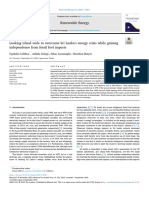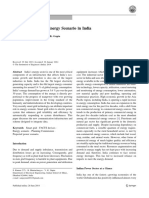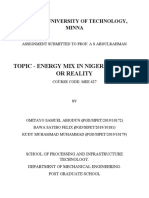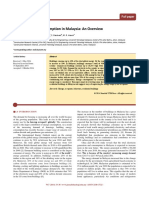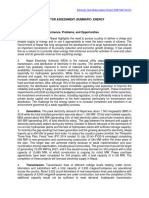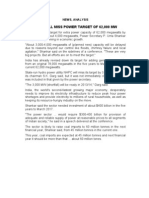Solar Energy and Its Role in Sri Lanka: G.H.D.Wijesena, A.R.Amarasinghe
Solar Energy and Its Role in Sri Lanka: G.H.D.Wijesena, A.R.Amarasinghe
Uploaded by
Lakshani AkalankaCopyright:
Available Formats
Solar Energy and Its Role in Sri Lanka: G.H.D.Wijesena, A.R.Amarasinghe
Solar Energy and Its Role in Sri Lanka: G.H.D.Wijesena, A.R.Amarasinghe
Uploaded by
Lakshani AkalankaOriginal Description:
Original Title
Copyright
Available Formats
Share this document
Did you find this document useful?
Is this content inappropriate?
Copyright:
Available Formats
Solar Energy and Its Role in Sri Lanka: G.H.D.Wijesena, A.R.Amarasinghe
Solar Energy and Its Role in Sri Lanka: G.H.D.Wijesena, A.R.Amarasinghe
Uploaded by
Lakshani AkalankaCopyright:
Available Formats
International Journal of Engineering Trends and Technology ( IJETT ) – Volume 65 Number 3 – November 2018
Solar Energy and its Role in Sri Lanka
G.H.D.Wijesena#1, A.R.Amarasinghe*2
#
Chief Technical Officer, Dept. of Textile & Clothing Technology., Faculty of Engineering,
* Technical Officer, Dept. of Earth resources Engineering. , Faculty of Engineering,
University of Moratuwa, Sri Lanka
Abstract
Solar energy a clean renewable source with no I. INTRODUCTION
emission and low recurring cost. In past recent years
the technology of solar energy and its usage has Due to economic growth production and industrial
experienced a phenomenal change and rapid growth. development, Sri Lanka is facing an acute power and
Promotional and encouraging government policies energy scarcity. Her energy sector has made
about solar energy, technological improvements in tremendous progress over the last two and a half
less setup and maintenance cost, growing public decades in bringing electricity to almost everyone in
awareness in environmental issues, easy way to the country. But there’s a requirement of diversify
cutting down the users electricity bills with assured the country's energy generation toward more
power supply 24x7 are some of the facts that have renewable and sustainable sources. She has exploited
facilitated and sustained this strong interest in the hydropower resources to almost her maximum
minds of the users about solar technology worldwide economical potential. Only a very few small scale
including Sri Lanka. hydropower plants are yet to be developed in the
We all are facing the challenge of climate changes. country, which are under various stages of
According to World Bank report release in August construction.
2016, Sri Lanka loses 7.7% of its income due to
environment pollution specially from burning fossil However, the country remains extremely hooked on
fuels[5]. By setting up renewable environment to fossil fuels. In 2016, thermal power contributed
friendly energy sources are aimed to prove countries sixty seven percent of the total power generation
contribution to global effort and support to reduce the compared to hydropower's twenty five percent and
climate challenges. Sri Lankan government’s budget eight percent of nonconventional renewable sources.
proposals for the year 2018 has presented strategies This dependence on carbon-emitting energy sources
for environmental friendly developments to the makes the country prone to unsteady fuel costs, while
country based on the United Nations sustainable hampering the government's efforts to reduce
development goals. greenhouse gas emissions by 20% as part of its
As a geographical advantageously located topical commitment to the Paris agreement.
country close to equator, where sunlight remains 365
days per year, 8 to 10 hours a day, is a great intensity The Year 2014 became a landmark in the thermal
for generation of solar electricity. Therefore solar generation, with the addition of Norochchole Coal
energy has a great potential as future energy source Plant, with 600MW to national grid. In recent years,
in Sri Lanka. the Sri Lankan government has increased its
Present consumption level of electricity is about generation power based on renewable energy sources,
12,000 GWh, with an increase rate of 6.5% to 9% with a 20% of electricity generation targeted from
annually[2]. Ceylon Electricity Board had identified NCRE by 2020[1]. Sri Lankan government target’s an
that Sri Lanka needs additional 4000GWh by end of addition of 200MW to the grid by 2020, increase up
2025 [1]. This amount is planned to be generated to 1000MW by 2025 from solar power generation
through solar energy, other renewable and other projects.
indigenous energy resources. Sri Lankan
government’s aim of electrification 100% of houses II. GROWTH OF POWER DEMAND AND
became a success. But without adequate supplies of GENERATION IN SRI LANKA
affordable energy at reasonable generation cost, it is
impossible to achieve the future targets. A. Access to Electricity
The project “Battle of Solar Power” is a By the end of December 2014, approximately
progressive turn to convert customers rooftop into a 98.4% of the total population had access to electricity
solar power plant is one major economical green from the national electricity grid[2]. Some planned
project. Sunlight is a free resource, the foreign electrification schemes are implemented and some are
exchange spend on fossil fuels will be remain in the finished. Figure 1 shows the percentage level of
country. electrification district wise as at end of 2014 [1].
Keywords — Battle of solar energy, solar Sri Lanka,
zero emission, renewable energy
ISSN: 2231 – 5381 http://www.ijettjournal.org Page 141
International Journal of Engineering Trends and Technology ( IJETT ) – Volume 65 Number 3 – November 2018
Least Cost Long Term Generation Expansion Plan
(LCLTGEP) 2018- 2037. According to LCLTGEP,
Ceylon Electricity Board (CEB) will not setup new
coal power plants in future. PUCSL approved
242MW of major hydro, 215MW of mini hydro,
1,389MW of solar, 1,205MW of wind, 85MW of
biomass, 4,800MW of natural gas, 330 MW of
furnace oil based power and 105MW of gas turbine
power to fulfil countries power requirements in 20
years period [12]. Considering all the benefits of
solar power to supply the country’s electricity
requirement from green energy sources, the Ministry
of Power and Renewable Energy had decided to
introduce one hundred thousand rooftop solar units
during the next ten years as a national program.
Figure 1 .
C. Electricity Consumption
B. Electricity Generation The annual total electricity demand and
Many countries including Sri Lanka, blessed consumption rate is set to increase much more in next
rivers and waterfalls have harnessed their inherent recent years due to ongoing development projects,
kinetic energy through hydro-electricity in fulfilling increasing rural connectivity, increase and becoming
their energy desires. But the rising demand for popularity of electrical operated vehicles and the
electricity and the restricted generation potential of planned railway electrification project etc. In this
existing hydro plants, reduced the relative pretext it is clear that a strategic balance between the
contribution of hydro power generation. As a solution electricity demand and supply has to be maintained
to the limitations given above, Sri Lanka had taken a with a long term perspective. Considering this fact
policy decision to move towards thermal and coal setting up new generation plants is very essential to
electricity generation. However, this leading to issues, support the shady economic growth.
such as rising electricity prices and contributes to The amount of energy consumed by each sector from
negative environmental externalities. 2004 to 2014 is shown in figure 2, while Figure 3
depicts sectorial electricity consumption share in
Since the commission of the first hydroelectric 2014. These Figures reveal that the industrial and
generation plant in 1950 at Laxapana, hydropower commercial consumption is more than the
has played a major role in power generation in Sri consumption in the domestic sector. This is a pleasing
Lanka. In fact, the biggest share of electricity situation for an economy with ambitious GDP growth
generation came from major hydro development projections [17].
projects till 1990s. Since then, electricity generation
has been transferring from hydroelectric system to a The average per capita electricity consumption in
mixed hydro and thermal system, presently 2013 and 2014 were 519kWh per person and 535
dominated by oil. Thermal power has presently kWh per person respectively. [1].
become the key supply of electricity generation.
Sri Lanka’s Public Utilities Commission(PUCSL), the
electricity sector regulator, has approved an alternate
Table 1 - Sri Lanka power generation in GWh with production source from 2010 to 2015
Year / Production source 2010 2011 2012 2013 2014 2015 2016
CEB Hydro 4988.4 3972.6 2726.7 6010.0 3649.7 4904.4 3481.9
Thermal, CEB, IPP and
Hired 5063.3 6884.0 8416.4 4819.7 7944.3 6796.4 9630
CEB Wind 2.9 2.6 2.3 2.3 2.1 1.6 2.1
New Renewable Energy 728.4 722.2 733.3 1168.7 1215.3 1466.0 1,157.8
Net-metered Projects 0 0 0 4.7 18.6 38 70.7
Off-Grid, 17.4 18.2 18.7 18.7 18.7 18 18.8
Gross Generation Sri Lanka 10800.7 11599.8 11897.6 12024.3 12848.8 13225.5 14361.3
Source: Sri Lanka Sustainable Energy Authority
ISSN: 2231 – 5381 http://www.ijettjournal.org Page 142
International Journal of Engineering Trends and Technology ( IJETT ) – Volume 65 Number 3 – November 2018
Table 2 - Total Electricity Use Sri Lanka (GWh)
Year 2010 2011 2012 2013 2014 2015 2016
Total Electricity Use Sri
Lanka (GWh) 9208.5 9989.9 10409.2 10554.5 10996.9 11740.9 12715.0
Source: Sri Lanka Sustainable Energy Authority
Domestic Religious Industrial General Street Lighting
Figure 2 - Sectorial Consumption of Electricity (2004 - 2014)
Street Lighting, 1%
Commercial, 27% Domestic, 37%
Industrial, 34% Religious, 1%
Figure 3 - Sectorial Consumption of Electricity (2014)
D). Key challenges faced by the Sri Lankan power As no solar panel or related equipment’s are
sector produced locally, the cost and amount of foreign
Below highlighted are some key challenges faced by exchange spend on equipment are high.
the Sri Lankan power sector and should be Any variation in the climate pattern hardly hits
proactively tackled to over come countries electricity Sri Lankan energy sector as largely depend on
crises.[4]. hydro power.
Large investment required for generation,
transmission and distribution and its III. GLOBAL SOLAR POWER SCENARIO
infrastructure development.
Technical challenges on grid balancing (now Solar energy has rapidly becoming as an alternative
only balance through hydro plants) energy source across the world due to low generation
Very less number of researches carried out on costs involved as a free natural resource, and the
promoting to local capacity development. favourable environmental impact with no emissions
Slow improvement on rooftop solar plant scheme and environmental degradation.
due to lack of proper education on inverters / In past few years new interest has arrived to people’s
customers. mind, about the use and effectiveness of the
Limited financial facilities for rooftop solar renewable power throughout the world. Greenhouse
projects from commercial banks. gases and environmental pollution show a continuous
increment in quantity. Many countries are giving
more emphasis on using environment friendly
ISSN: 2231 – 5381 http://www.ijettjournal.org Page 143
International Journal of Engineering Trends and Technology ( IJETT ) – Volume 65 Number 3 – November 2018
renewable energy as their energy source. In 2013, Hydro Power – 2361 3.37
approximately 19.1% of global total energy CEB
consumption was provided by renewable energy Thermal – CEB 3029 11.47
sources. With a significant progress in all the regions plants
at the end of 2014, renewable resources have supplied Thermal – Hired / 403 34.69
27% of world's total. Private
By continuing the development activity in solar Renewable / Solar 607 16.97
power generation, USA and China have been able to Table 3 : Generation Cost- 2015 January to June
present themselves to the top places in the world. Source : Generation Performance in Sri Lanka - 2015
According to the records as on 30-09-2015, the
largest solar power plant in the world is ―Solar Star‖ For any situation incorporating renewable energy
in USA with a 579 MW generation capacity. While within the electricity generation combined or mix to
India is installing their largest solar power plant succeed in Sri Lanka, it’s imperative that it address
named ―Charaka Solar Park‖ aimed to generate the challenges and deploy measures to mitigate them
500MW at full capacity. ―Longyangxia Dam Solar to the furthest extent possible.
Park‖ is China’s largest solar power generation plant
with 320MW capacity. while Bangladesh is also V. BATTLE FOR SOLAR ENERGY
rapidly expanding investments in this area with the (SOORYA BALA SANGRAMAYA)
aim to power 6 million households with solar power
by 2018 [6]. The project ―Battle for Solar energy‖ is a
community based electricity generation program
IV. WHY SOLAR POWER IN SRI LANKA introduced to integrate the solar electricity generated
in premises of electricity customers through rooftop
Sri Lanka is located near to the equator, therefore solar panels to the national grid. This also can express
receives an abundant supply solar radiation year as roof top power station project, every building
around. Solar radiation over the island doesn’t show a whether home, industry, institution or commercial
marked seasonal variation. establishment can generate some solar power by
installing PV panels on their roof tops. The maximum
As estimated in the solar resource map developed installed capacity is upon to contract demand of that
by NREL of the USA, over most parts of the flat dry particular customer. Ceylon Electricity Board will
zone in Sri Lanka, which accounts for two-thirds of sign a contract up to 20 years with the customers who
the land area, solar radiation varies from 4.0 – 4.5 join this program. Studies reported that small solar
kWh/m2/day[9]. But there are a number of factors power plants built on rooftops are highly beneficial.
that can affect how much electricity will generate economical, environmental and social benefits can be
from any solar panels installed[10]. specially achieved through rooftop solar energy
power plants. .
A. Some key benefits aimed by “Battle for Solar
energy” mission
Rooftops small solar power plants are giving
tremendous contribution to the balance of the
electricity system which are scattered all over the
island.
Transmission and distribution losses are minimal
as consumer and generator are close to each
other.
Not only multi-million companies, but also small
scale entrepreneurs also can join the electricity
production.
When the customers of electricity have become
Figure 4 – Sri Lanka annual solar radiation the producers, their economy will be developed
(Source : solar resource map developed by NREL Because of these small scale electricity
of the USA) generation roof tops scattered across the island, it
positively affect the security of the electricity
Generation cost comparison in first half of 2015 is
supply.
given in table 3
Generation type Generation Average Because of this free source of solar energy, the
in 2015 First unit cost foreign exchange spend on fossil fuels will be
Half – GWh (Rs./kWh) reduced.
ISSN: 2231 – 5381 http://www.ijettjournal.org Page 144
International Journal of Engineering Trends and Technology ( IJETT ) – Volume 65 Number 3 – November 2018
An additional income will come to the hands of (300 sq. kW/h
the generators hands. feet)
Planned to add 200 MW to the grid by 2020 and Table 5 – Solar investment and out come
upgrade to 1000 MW by 2025. * Approx. Cost with warranty conditions for the
system
Ability to reduce Carbon Dioxide (CO2)
Solar Module : 25 years linear performance ,
emission from thermal power plants to 1,50,000 Inverter and structure : 10 years
MT Source:www.jlankatech.com/,
Calculations show customer who joins this www.khmsolar.com/product-pricing.html,
scheme is able to receive a monthly income of www.ceylonsolarpower.lk/
about Rs.300/= for the first 7 years after paying
the bill and interest. Also Rs.2500/= monthly Considering all the benefits of battle of solar power
from the 8th to 20th year. mission and to supply the countries electricity
A large number of direct and indirect jobs with requirement from green energy sources, ministry of
the awakening occurred in this field. power and renewable energy had decided to introduce
and install one hundred thousand solar rooftops as a
In the mission ―Battle for Solar energy‖ electricity national programme in next ten years. Once complete
customer has to pay back the loan amount within the this mission at least 18% of electricity to be produced
first 7 years after the initial investment made for the by the electricity customers in Sri Lanka. Present, the
purchase of solar panels to fix on their roof tops. generation of solar power at domestic level is mostly
Hence it is proposed to pay a higher rate for a unit of restricted among high income and upper middle class
electricity during the first 7 years to cover their people. The reason behind that is the non-payment for
investment capital and the bank interest. For the the excess electricity customers feed to the network.
period of next 8-20 years, it is proposed to purchase To attract low income electricity consumers for solar
the generating electricity at a price offering a energy mission, ministry had introduced some
reasonable benefit for the customer for their promotional schemes. Upon these promotion schemes
investment. ministry aims another twenty thousand low income
families will become producers of electricity. It is
If a customer has fixed a solar panel of 1kW on his expected to produce 200 MW by the year 2020 from
rooftop, according to Sri Lankan climate conditions the proposed project and increase it up to 1000 MW
he can generate approximately 115 – 125 units per by the year 2025.It is proposed to setting up roof top
month. According to the proposed rate of payment, he power plants as much as possible on government
would be able to get an income about Rs.2500/- buildings as a government policy. State owned banks
2700/- monthly. If the customer had taken a bank loan and some related organisations offer their maximum
facility for fixing of solar panes, he has to pay about cooperation for this program to its success.
Rs. 2200/- monthly if the loan period is 07 years and Other than to roof tops some large scale solar power
the interest rate is 8% to 13%. According to the plants are setting up with private sector investment.
proposed payment plan, the consumers will be able to Despite at least half a dozen private companies
retain about Rs.300/- per month after paying off loan applying for development permits or working for
instalment, interest, and the cost of electricity photovoltaic and solar thermal projects [14].
consumption. If the loan scheme is more First commercial scale solar power station was setup
concessionary, the income level of the customer will in Hambantota, known as Buruthakanda Solar park.
be increased. After paying off the loan instalments in The plant is owned and operated by the Sri Lanka
07 years, they will be able to get about Rs.2500/- Sustainable Energy Authority, a government owned
2700/- monthly as a net income for a further period organization responsible for the development of
up to 20 years. renewable resources in Sri Lanka. Buruthakanda
Solar park power station was setup in two stages with
System Space Approx. Cost Approx. generation capacity of 737kW in first stage with a
Size required with annual cost of Rs. 1202 million, funded by the Japanese
warranty* output Government. Second stage with 500kW of generation
SLR capacity, cost Rs. 637 was funded by the Korean
1 kW 7 sq. m 300,000.00 1500 Government. [14]. A generation capacity of 20MW,
(72 sq. feet) kW/h with an estimated total investment of around Rs.5
2 kW 14 sq. m 500,000.00 2900 billion was setup by LAUGFS Gas PLC, The plant is
(144 sq. kW/h located Hambantota district[15].
feet) Hatton National Bank head office branch generate
3 kW 21 sq. m 750,000.00 4250 1.3MW of solar power while MAS Holdings
(216 sq. kW/h unveiling of Sri Lanka’s another large rooftop solar
feet) plant at the MAS Fabrics Matrix plant inside its
4 kW 28 sq. m 900,000.00 5600 Fabric Park in Thulhiriya with a capacity of 1
ISSN: 2231 – 5381 http://www.ijettjournal.org Page 145
International Journal of Engineering Trends and Technology ( IJETT ) – Volume 65 Number 3 – November 2018
MW[18]. Another large commercial based at 3. Annual output calculation in PV system
Wellampitiya by Expolanka Holdings PLC Group Formula given below is used to calculate the
with 2326 solar panels, an energy production estimated electricity generated in a photovoltaic
capacity of 651 kw. system.
VI SOLAR THERMAL ELECTRICITY E = A * r *H * PR
PROCESS Where,
E = energy (kWh)
Solar thermal electricity technologies turn out A = total solar panel area (sq. m)
electrical power by changing the sun’s energy into hot r = solar panel efficiency(%)
temperature heat using numerous mirror H = average solar radiation absorbed by panel (per
configurations. This is similar to on-site power plant year, shading not considered)
and used to make electricity through traditional heat- PR = performance ratio
conversion technologies. Solar plant made out of two
parts. One collects solar energy and converts to heat, Performance Ratio one very considerable value when
while another converts the heat energy to electricity evaluating the quality of a photovoltaic installation.
This gives the performance of the installation
A. Solar cell independently of the orientation, inclination of the
A solar cell is a semiconductor device that panel. It includes all losses such as Inverter losses,
transforms daylight into electricity. Semiconductor Temperature losses, DC cables losses, AC cables
material is placed between two electrodes. Free losses, shading, looses at weak radiation and dust
negatively charged electrons are discharged from the etc ...
material, when sunshine reaches the cell. Which Some calculated losses considered for the PR value
enabling conversion to electricity. This is the so- is as below
called photovoltaic effect. In theory, a solar cell made - Inverter losses (4% to 10 %)
out of semiconductor material only can convert about - Temperature losses (5% to 20%)
30% of the solar radiation energy it is exposed to into - DC cables losses (1 to 3 %)
electricity. An efficiency of 5% to 12% on thin films - AC cables losses (1 to 3 %)
and 13% to 21% for crystalline silicon based cells are - Shadings 0 % to 80% (specific to site)
commercially available in the market. Up to 25% - Losses at weak radiation 3% to 7%
efficiency level has been reached by the use of - Losses due to dust... (2%) and
laboratory processes and some combined testing level - Other Losses (to be measured )
multiple solar cells achieved efficiencies above
35percent. VI. ECONOMIC IMPACT
B. Solar photovoltaics Sri Lanka totally depend on the import of fossil
Solar photovoltaic is a derivation from the fuels as no fossil fuel deposits. This results in high
combination of words. Where photo suggests the unbearable import costs. Historically, Sri Lanka has
word light and voltaic suggests the word electricity. to import 46% to 50% of its total energy used
Highly-purified silicon materials are used as annually. This is a major burden on countries
photovoltaic material that, converts sunlight directly economy, which can be offset by shifting focus to
into electricity renewable energy sources.[4]
A. Electricity and Economy
The growth rate of Sri Lankan economy and its
electricity demand has most of the times revealed a
direct correlation. Somehow the elasticity of
electricity usage with respect to GDP is less
significant in the recent past. Figure 6 shows growth
rates of electricity demand with GDP for past ten
years period.
Figure 5 - From a solar cell to a PV system.
Diagram of the possible components of a photovoltaic system
https://en.wikipedia.org/wiki/Solar_cell
ISSN: 2231 – 5381 http://www.ijettjournal.org Page 146
International Journal of Engineering Trends and Technology ( IJETT ) – Volume 65 Number 3 – November 2018
increase in the thermal generation share to 65% by
2034 from approximately 48% to 55% share of
present thermal generation. Hence, a substantial
increase in the use of fossil fuels in the power sector
seems inevitable.
VIII. ADVANTAGES OF
SOLAR ENERGY
Solar energy obtained from the sun’s radiation and
it may be born-again to electricity or heat. It is freely
offered and due to advances in technology, will
currently harness even a lot of solar power that is
continuously offered to us.
Here are most common benefits related to this
Figure – 6 - electricity demand and GDP renewable source of energy. Solar energy has smallest
Source – Annual Report 2014 – Central Bank of Sri negative impact on our surroundings compared to
Lanka other energy supplies used by us. It doesn’t
manufacture greenhouse gases and doesn’t foil the
B. Economic Projections water or water sources. It need very little or no water
The Central Bank of Sri Lanka expects 8% for its maintenance or services. No noise pollution in
average GDP growth rate in real terms in the four solar power generation is major benefit, as most of
years from 2015 to 2018. The Central Bank GDP solar rooftop installations are in urban areas.
growth rate forecast is depicted in Table 5. Generating your own electricity means you’ll be
Year 2014 2015 2016 2017 2018 victimization less from the utility provider. This will
2013 7.8 8.2 8.3 8.4 in real time translate to savings on your electricity
Forecast bill. Further provide a path to earn money by selling
2014 7.0 7.5 8.0 8.0 the unused electricity, back to the national grid. As
Forecast long as there is sunshine, solar power is deployed
Table 5 - Forecast of GDP Growth Rate in Real Terms from any location. This is particularly useful for
remote regions with no access to other source of
Source: Annual Reports 2013 & 2014, Central Bank electricity. Some of the energy, around 3-5 percent, is
of Sri Lanka lost during transportation and distribution. Energy
Accordingly the power supply also to be increased to losses directly depend on the distances between the
fulfil the growth of the demand. production and the supply points, if the distance is
longer more energy is lost. Having installed solar
VII. ENVIRONMENT IMPACT panels on the rooftops in regions with high population
density or in the yard significantly minimize this
The impact of electricity generation on the transmission distance. Therefore small scale solar
environment could be due to one or several factors plants or rooftop solar generation increasing the
including: particulate emissions; gaseous emissions efficiency of the electrical system.
(CO2, SOX, NOX etc.); warm water discharges into
lakes, rivers or sea; liquid and solid waste (sludge, Spread out many power plants ensure less
ash); inundation (in the case of large reservoirs) and blackouts. A grid with high penetration of solar
changes of land use. Though some of these are energy has thousands of energy production stations
common to any developments, particulate and which are spread out all over the country. This also
gaseous emissions are one of primary importance in can upgrade the security of the grid in overloading,
the case of power generation using fuels. But when either by natural or by human-caused disasters. A big
compare with solar energy systems pollution is far part of the capital is associated with solar systems
less compared to others. Although some toxic comes from the installation of solar panels. Solar
materials and human harmful products are used rooftops contribute a lot to local job creation
during the manufacturing process of solar recently..
photovoltaics, which can indirectly affect the
environment. Nevertheless, solar energy pollutes is
very less compared to other alternative energy Out of few disadvantages to be considered are the
sources. Hence, the power sector has so far initial cost of purchasing a solar system, its dependent
contributed very little to greenhouse gas emissions. on weather condition, sunlight to effectively gather
Since 1995 this situation has been changing in Sri solar energy and requirement of , lot space.
Lanka.. Proposed expansion sequence predicts an
ISSN: 2231 – 5381 http://www.ijettjournal.org Page 147
International Journal of Engineering Trends and Technology ( IJETT ) – Volume 65 Number 3 – November 2018
IX. CONCLUSIONS http://dailynews.lk/2017/01/16/business/104709/hayleys-
unveils-high-capacity-solar-power-plant-welikanda
[17] Sri Lanka energy sector development plan for a knowledge
Hence looking at all perspective side’s along with based economy [online] Available :
future development of our country it is necessary to http://powermin.gov.lk/sinhala/wp-
begin with small baby steps towards getting a clean content/uploads/2015/03/ENERGY_EMPOWERED_NATI
source of energy like solar to achieve long terms ON_2015_2025.pdf
[18] MAS unveils one of South Asia’s largest Solar Solutions
goals with a clean, green environment for future with a State of Mind [online] Available :
generations. Along with active support from http://newsline.masholdings.com/mas-unveils-one-of-south-
Government by way of friendly policy decision, asias-largest-solar-solutions-with-a-state-of-mind/
subsidies. Also the corporate world can help under [19] Ashok Upadhyay, Arnab Chowdhury - Solar Energy
Fundamentals and Challenges in Indian restructured power
social obligation scheme. The support of NGO’s sector "International Journal of Scientific and Research
would be a welcome step too. Least but most Publications (IJSRP), Volume 4, Issue 10, October 2014
important we as the proud citizen’s of our country Edition"
it’s our duty to conserve more electricity along with [20] PIF Process industry forum [online] Available :
http://www.processindustryforum.com/hottopics/advantages
taking active participation in scheme’s success for a -and-disadvantages-of-solar-energy
beautiful, green and happy tomorrow [21] http://powermin.gov.lk/bfse/wp-
content/uploads/2016/09/Solargis-Sri-Lanka-GHI-solar-
REFERENCES resource-map-en.png
[22] Upali Daranagama ―Development of solar PV Deployment
in Sri Lanka and its challenges‖ [online] Available :
[1] Ceylon Electricity Board - LONG TERM GENERATION https://d2oc0ihd6a5bt.cloudfront.net/wp-
EXPANSION PLAN 2015-2034 [online] Available : content/uploads/sites/837/2017/06/10_Development-of-
http://www.ceb.lk/index.php?aam_media=4464 Solar-PV-in-Sri-Lanka.pdf
[2] Ministry of Power and Energy,‖ Sri Lanka Energy Sector [23] The Environmental and Public Health Benefits of Achieving
Development Plan for a Knowledge-Based Economy 2015- High Penetration of Solar Energy in the United States
2025‖ [online] Available : [online] Available :
http://powermin.gov.lk/sinhala/wp- https://www.energy.gov/eere/solar/downloads/environmenta
content/uploads/2015/03/ENERGY_EMPOWERED_NATI l-and-public-health-benefits-achieving-high-penetration-
ON_2015_2025.pdf. solar
[3] Ministry of Power and Energy, ―National Energy Policy and [24] Annual Report 2013, Central Bank of Sri Lanka
Strategies‖. [online] Available : http://powermin.gov.lk/ [25] Annual Report 2014, Central Bank of Sri Lanka
english/wp- [26] Jinwon Bae and Sandy Dall’erba ―The Economic Impact of
content/uploads/documents/national_energy_policy.pdf. a New Solar Power Plant in Arizona: Comparing the Input-
[4] 100% ELECTRICITY GENERATION THROUGH Output Results generated by JEDI vs. IMPLAN‖ [online]
RENEWABLE ENERGY BY 2050, Assessment of Sri Available : http://www.real.illinois.edu/d-paper/15/15-T-
Lanka’s Power Sector, Co-publication of the Asian 5.pdf
Development Bank and the United Nations Development
Programme [online] Available : http://www.undp.org
[5] World Bank Data Bank [online] Available :
http://databank.worldbank.org/data/reports.aspx.
[6] World Energy Resources: Solar World Energy Council 2013
[online] Available : https://www.worldenergy.org/wp-
content/uploads/2013/10/WER_2013_8_Solar_revised.pdf
[7] Hydro power and Sri Lanka’s energy challenge [online]
Available : http://www.dailymirror.lk/44934/hydro-power-
and-sri-lankas-energy-challenge#sthash.5uXBA8CG.dpuf
[8] Renewables 2015, Global Status Report: Annual Reporting
on Renewables: Ten years of excellence‖, REN21
(Renewable Energy Policy Network for the 21st Century).
[9] ―Technology Roadmap: Solar Photovoltaic Energy, 2014‖,
International Energy Agency (IEA), [online] Available :
http://www.iea.org/publications/freepublications/
publication/technology-roadmap-solar-photovoltaic-
energy—2014-edition. html
[10] ―Renewable energy and the environment‖ [online]
Available : https://www.theecoexperts.co.uk/how-much-
electricity-can-i-generate-solar-panels
[11] ―Sri Lanka Next‖ Neela Haritha Ugayak [online] Available :
http://www.srilankanext.lk/sri-lanka-next.php
[12] No coal in Sri Lanka’s PUCSL approved long-term power
generation plan [online] Available :
http://www.lankabusinessonline.com/no-coal-in-sri-lankas-
pucsl-approved-long-term-power-generation-plan/
[13] Clean Technica– Solar Power, [online] Available:
http://cleantechnica.com/solarpower/.
[14] List of power stations in Sri Lanka Form [online]
[15] Largest power plant by LAGUFS [online] Available :
http://www.lankabusinessonline.com/sri-lankas-largest-
solar-power-plant-by-laugfs-takes-off-ground/
[16] Hayleys unveils high capacity solar power plant in
Welikanda [online] Available :
ISSN: 2231 – 5381 http://www.ijettjournal.org Page 148
You might also like
- Play of Shadows - Sebastien de CastellDocument473 pagesPlay of Shadows - Sebastien de CastelldsfasdfaNo ratings yet
- Solar Generator ReportDocument26 pagesSolar Generator ReportHasan HemaniNo ratings yet
- Three Card Tarot Spreads PDFDocument18 pagesThree Card Tarot Spreads PDFnatalcas100% (5)
- Jurnal 3 (Internasional)Document17 pagesJurnal 3 (Internasional)Muhammad HumamNo ratings yet
- Activity No. 1: Proposed 650Mw Coal-Fired Power Plant DesignDocument15 pagesActivity No. 1: Proposed 650Mw Coal-Fired Power Plant DesignCarlo SebastianNo ratings yet
- Power and Energy Industry in IndiaDocument16 pagesPower and Energy Industry in IndiaSayan MaitiNo ratings yet
- Policybrief RenewableDocument16 pagesPolicybrief Renewable41 Nissanth KNo ratings yet
- 1.1 in More Ways Than One, 2014-15 Has Been A Decisive Leap Forward ForDocument32 pages1.1 in More Ways Than One, 2014-15 Has Been A Decisive Leap Forward ForsrinNo ratings yet
- Towards Energy Sustainability Bangladesh PerspectivesDocument17 pagesTowards Energy Sustainability Bangladesh PerspectivesElisa PrandoNo ratings yet
- The Prospect of Solar Energy in BangladeshDocument7 pagesThe Prospect of Solar Energy in BangladeshMD IMON HOSSENNo ratings yet
- Chapter 1 and 2 FINAL 2Document21 pagesChapter 1 and 2 FINAL 2John Louie PimentelNo ratings yet
- 14 EnergyDocument20 pages14 EnergyMehar HassanNo ratings yet
- GRID Integration of Renewable Energy SourcesDocument9 pagesGRID Integration of Renewable Energy SourcesmanasasurendraNo ratings yet
- Present and Future Energy Scenario in IndiaDocument8 pagesPresent and Future Energy Scenario in IndiaRomario OinamNo ratings yet
- Materials - Energy Economics-19.03.17Document83 pagesMaterials - Energy Economics-19.03.17AbdullahNo ratings yet
- Conventional and Renewable Energy Scenario of India by Gopal PrasadDocument7 pagesConventional and Renewable Energy Scenario of India by Gopal PrasadGopal Prasad BansalNo ratings yet
- A Mathematical Approach To Analyze Factors Influencing Adoption of Solar Based Power Production in Residential Buildings in Tamilnadu State of IndiaDocument12 pagesA Mathematical Approach To Analyze Factors Influencing Adoption of Solar Based Power Production in Residential Buildings in Tamilnadu State of IndiaPraveen PaulNo ratings yet
- Matching Electricity Supply With Demand in NigeriaDocument5 pagesMatching Electricity Supply With Demand in NigeriaaishatuNo ratings yet
- Topic - Energy Mix in Nigeria A Myth or Reality: Federal University of Technology, MinnaDocument14 pagesTopic - Energy Mix in Nigeria A Myth or Reality: Federal University of Technology, MinnaMuhammad Kudu MuhammadNo ratings yet
- First Revised Karnataka R.E.policy DraftDocument23 pagesFirst Revised Karnataka R.E.policy DraftGuru VagaNo ratings yet
- Decarbonization Pathways For The Power Sector in Sumatra, IndonesiaDocument11 pagesDecarbonization Pathways For The Power Sector in Sumatra, IndonesiaitziarNo ratings yet
- Wwind MillDocument35 pagesWwind MillRaja ManeNo ratings yet
- Template For For The Jurnal TeknologiDocument6 pagesTemplate For For The Jurnal TeknologiAndrianus Emank JeniusNo ratings yet
- IESR Technical Note Residential Rooftop Solar Potential in 34 Provinces ID PDFDocument16 pagesIESR Technical Note Residential Rooftop Solar Potential in 34 Provinces ID PDFDavid Firnando SilalahiNo ratings yet
- Energy Sector AssessmentDocument6 pagesEnergy Sector Assessmentmeendhami62No ratings yet
- Power Sector OverviewDocument9 pagesPower Sector OverviewMuneer AhmedNo ratings yet
- Prospect of Renewable Energy Resources in BangladeshDocument9 pagesProspect of Renewable Energy Resources in BangladeshInternational Journal of Power Electronics and Drive SystemsNo ratings yet
- The Energy Sector in Egypt - August 2023 - OstoulDocument5 pagesThe Energy Sector in Egypt - August 2023 - Ostoulhesham zakiNo ratings yet
- Increasing Energy Efficiency of Buildings in Serbia-A Case of An Urban NeighborhoodDocument20 pagesIncreasing Energy Efficiency of Buildings in Serbia-A Case of An Urban Neighborhoodluka.work90No ratings yet
- Power Scenario of IndiaDocument39 pagesPower Scenario of IndiaHoney AbdullahNo ratings yet
- Scenario of Energy Recourses in PakistanDocument9 pagesScenario of Energy Recourses in PakistaneisaNo ratings yet
- Upali Daranagama - Solar Energy Devt in Sri LankaDocument24 pagesUpali Daranagama - Solar Energy Devt in Sri LankaADB_SAEN_ProjectsNo ratings yet
- Overview of Power SectorDocument26 pagesOverview of Power SectorRameswar DashNo ratings yet
- Analysis of Perceptions Towards The Rooftop PV Solar System Policy in IndonesiaDocument10 pagesAnalysis of Perceptions Towards The Rooftop PV Solar System Policy in Indonesiaibtor007No ratings yet
- India Will Miss Power Target of 62,000 MW: News, AnalysisDocument10 pagesIndia Will Miss Power Target of 62,000 MW: News, AnalysisdevavasanNo ratings yet
- Kenya The Role of Green Mini GridsDocument6 pagesKenya The Role of Green Mini GridsPrabha Karan.nNo ratings yet
- Renewable EnergyDocument6 pagesRenewable EnergyFarabi GulandazNo ratings yet
- BK EMP SUSTAINABILITY - ASIA 220237 Chp02Document17 pagesBK EMP SUSTAINABILITY - ASIA 220237 Chp02rishimaran36No ratings yet
- Cep ReportDocument13 pagesCep Reportalizabano9fNo ratings yet
- MNRE Annual Report 2019-20Document192 pagesMNRE Annual Report 2019-204u.nandaNo ratings yet
- Mnre PDFDocument171 pagesMnre PDFPadhu PadmaNo ratings yet
- Energies 16 04645 v2Document21 pagesEnergies 16 04645 v2tuntuni77No ratings yet
- (Assignment) PDFDocument7 pages(Assignment) PDFKnight》 MinhajNo ratings yet
- IcoldDocument13 pagesIcoldkong yiNo ratings yet
- BCML II EnclosuresDocument46 pagesBCML II Enclosurespradeepika04No ratings yet
- Renewable Energy in India: Industry Information Insights 2015Document14 pagesRenewable Energy in India: Industry Information Insights 2015ashutosh2009No ratings yet
- IJER 2014 621 Selected Paper1Document7 pagesIJER 2014 621 Selected Paper1FestusNo ratings yet
- Demand Projection and Generation Planning: Reasons For SlippageDocument6 pagesDemand Projection and Generation Planning: Reasons For SlippageAnil SarangNo ratings yet
- Prospect of Reneable Enrgy in Baglagesh (BPDB)Document43 pagesProspect of Reneable Enrgy in Baglagesh (BPDB)ABDULLAH MD. ZOBAYER 1602090No ratings yet
- Jordan Toward A 100% Renewable Electricity SystemDocument14 pagesJordan Toward A 100% Renewable Electricity SystemMinh Pháp VũNo ratings yet
- Assig 1Document13 pagesAssig 1SriNo ratings yet
- Overview of Solar Electricity in Sri Lanka and Recycling ProcessesDocument29 pagesOverview of Solar Electricity in Sri Lanka and Recycling ProcessesAmal WahidNo ratings yet
- EconomicsDocument12 pagesEconomicsayanrNo ratings yet
- Rajasthan Solar Energy Policy 2019Document46 pagesRajasthan Solar Energy Policy 2019V S MITTALNo ratings yet
- Renewable Energy by EBCDocument9 pagesRenewable Energy by EBCMd Saidunnabi JohaNo ratings yet
- 17 33876 1 Report Kritwik PDFDocument22 pages17 33876 1 Report Kritwik PDFkritwik barua100% (1)
- China’s Route to Carbon Neutrality: Perspectives and the Role of RenewablesFrom EverandChina’s Route to Carbon Neutrality: Perspectives and the Role of RenewablesNo ratings yet
- Renewable Power Generation Costs in 2020From EverandRenewable Power Generation Costs in 2020No ratings yet
- Global hydrogen trade to meet the 1.5°C climate goal: Part III – Green hydrogen cost and potentialFrom EverandGlobal hydrogen trade to meet the 1.5°C climate goal: Part III – Green hydrogen cost and potentialNo ratings yet
- This Study Resource Was: ContentDocument9 pagesThis Study Resource Was: ContentLakshani AkalankaNo ratings yet
- Evolution and Development of Engineering Management Education in ChinaDocument4 pagesEvolution and Development of Engineering Management Education in ChinaLakshani AkalankaNo ratings yet
- The Concept of Cyber Defence Exercises (CDX) : Planning, Execution, EvaluationDocument9 pagesThe Concept of Cyber Defence Exercises (CDX) : Planning, Execution, EvaluationLakshani AkalankaNo ratings yet
- Assigment of Research PDFDocument37 pagesAssigment of Research PDFLakshani AkalankaNo ratings yet
- K To 12 Carpentry Learning ModulesDocument118 pagesK To 12 Carpentry Learning ModulesJerusJirehMayor88% (8)
- 18au503-Unit 1 - Fa-1Document10 pages18au503-Unit 1 - Fa-1RAJA TNo ratings yet
- 12 FamiliarDocument3 pages12 FamiliarErickson ElagoNo ratings yet
- Technology and Livelihood Education (TLE) : First Quarter - Module 6 Electrical Installation and MaintenanceDocument10 pagesTechnology and Livelihood Education (TLE) : First Quarter - Module 6 Electrical Installation and MaintenanceJo GuintoNo ratings yet
- E7756v1 3 PDFDocument82 pagesE7756v1 3 PDFxmieNo ratings yet
- Digital Eye Strain: By: DR - Khalid NazeerDocument27 pagesDigital Eye Strain: By: DR - Khalid NazeerJhakhar WelfareSocietyNo ratings yet
- Birth Death ProcessDocument4 pagesBirth Death ProcessDaniel MwanikiNo ratings yet
- S2 Underground Ukrainian War Update Feb 26 0100J 0800B v26Document28 pagesS2 Underground Ukrainian War Update Feb 26 0100J 0800B v26BFT BFT1No ratings yet
- Chapter 6 CardiovascularDocument10 pagesChapter 6 CardiovascularMarie Charmaine100% (1)
- 3-Day Juice Guide: Your Reboot QuickstartDocument4 pages3-Day Juice Guide: Your Reboot Quickstartflo_bachNo ratings yet
- Autobiographical Memory in AmnesiaDocument11 pagesAutobiographical Memory in AmnesiaCarlosNo ratings yet
- A Comparison Study of The Electrochemical Polishing of Laser Powder Bed Fusion HR 2 Stainless Steel and Alsi10MgDocument10 pagesA Comparison Study of The Electrochemical Polishing of Laser Powder Bed Fusion HR 2 Stainless Steel and Alsi10Mgsai charanNo ratings yet
- 184m5a0403 K.somasekhar 1Document23 pages184m5a0403 K.somasekhar 1Apple BaluNo ratings yet
- Physics 430: Lecture 15 Lagrange's Equations: Dale E. GaryDocument16 pagesPhysics 430: Lecture 15 Lagrange's Equations: Dale E. GaryfaniNo ratings yet
- Codevita 2013 Round 2Document9 pagesCodevita 2013 Round 2sirishaNo ratings yet
- Industrial Report Template Engineering v1Document99 pagesIndustrial Report Template Engineering v1Amirul HasanNo ratings yet
- Case Study On Arduino Contoled FansDocument2 pagesCase Study On Arduino Contoled FansAvaneesh Aravind HangalurNo ratings yet
- Mastering The 1Z0-078 Exam: Your Ultimate Guide With Comprehensive Dumps PDFDocument42 pagesMastering The 1Z0-078 Exam: Your Ultimate Guide With Comprehensive Dumps PDFwilliamnortiz090% (1)
- Ceng 3204 Lecture NoteDocument68 pagesCeng 3204 Lecture NoteDanielKibretTeshome94% (17)
- Politics: Batoche BooksDocument192 pagesPolitics: Batoche BooksClaire Elizabeth Abuan CacapitNo ratings yet
- EETimes July-August 2012Document56 pagesEETimes July-August 2012Brzata PticaNo ratings yet
- 24C Yoga Series PositiveDocument1 page24C Yoga Series PositiveastrowitharushiNo ratings yet
- Sciencedirect Sciencedirect SciencedirectDocument4 pagesSciencedirect Sciencedirect SciencedirectIshwarNo ratings yet
- ASL Scenario Conversions Set 4Document15 pagesASL Scenario Conversions Set 4Derek N.100% (1)
- Physics Hssc-Ii (3 Set) : Version No. Roll NumberDocument7 pagesPhysics Hssc-Ii (3 Set) : Version No. Roll NumberMuhammad HaseebNo ratings yet
- Simple Machines Stage 1-6Document3 pagesSimple Machines Stage 1-6api-281198656No ratings yet
- Conclusion - The Goblet of Relational Integrity (From Muse of The Long Haul)Document5 pagesConclusion - The Goblet of Relational Integrity (From Muse of The Long Haul)Ian Irvine (Hobson)No ratings yet
- Ensemble ControllerDocument2 pagesEnsemble ControllerArthur SeryNo ratings yet



